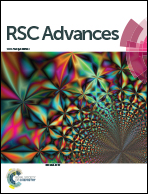Micro-aerobic digestion of high-solid anaerobically digested sludge: further stabilization, microbial dynamics and phytotoxicity reduction†
Abstract
Micro-aerobic digestion was firstly applied for further stabilization and phytotoxicity reduction of high-solid anaerobically digested sludge (ADS) in room temperature, mesophilic and thermophilic conditions. Organic matter degradation and microbial community succession were determined by fluorescent and X-ray photoelectron spectrometers, and Illumina MiSeq sequencing analysis during the process. Results showed that specific oxygen uptake rate, volatile solid and ammonia nitrogen contents of the ADS reduced by 36.1–86.4%, 8.4–16.2% and 70.2–85.4%, respectively after micro-aerobic digestion, and these changes had an increasing tendency with the temperature. They implied that micro-aerobic digestion promoted in-depth stabilization of the ADS, which temperature increase had a positive effect on. Protein-like and carbohydrate-like groups decreased, and humic acid-like and carboxyl materials enriched, while microbial community succession shifted from unassigned bacteria and Tepidimicrobium to Pseudomonas and Desulfuromonadales during the micro-aerobic process. Phytotoxicity tests revealed that micro-aerobic digestion reduced the inhibition of the ADS to germination and root growth of three plant seeds, but temperature had an adverse impact on the phytotoxicity reduction. Overall, the findings indicated that mesophilic micro-aerobic digestion was an alternative technique for the post-treatment of high-solid ADS.


 Please wait while we load your content...
Please wait while we load your content...